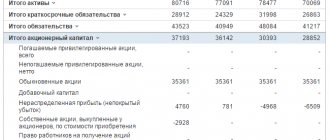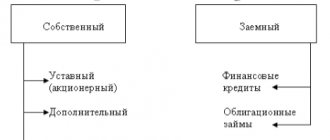Modern business conditions are characterized by the desire of many companies to overcome crisis phenomena and develop successful prospects for the development of debt policy, since borrowing funds is part of the business activities of any company, allowing it to maintain the capital structure, financial condition and creditworthiness. A necessary element of such a policy is to provide an information base for determining the need to attract borrowed sources with the need to maintain the financial flexibility of the company and diversify sources of financing.
The implementation of such tasks is possible only if the enterprise is provided with an accounting and analytical base that allows recording the company’s economic activities related to debt obligations, reflecting the costs of attracting debt sources.
The essence of the concept
Debt capital represents various debt obligations of the company, which are formed through external sources of financing.
Attracting borrowed capital within reasonable limits is profitable, since the cost of its servicing (interest paid) is written off as expenses, that is, it reduces taxable income.
An increase in the share of borrowed capital in the structure of financing sources entails an increase in the financial risk personified by this company, a decrease in reserve borrowed capital and an increase in the weighted average cost of capital of the company.
Equity ratio
The share of equity capital in the total amount of capital used by the company is a very important point in the work. Available funds help to increase work efficiency.
If borrowed funds predominate, then the company is financially dependent on creditors, which indicates a low asset liquidity ratio. The higher the financial stability indicator, the better for the organization.
To correctly calculate the equity concentration ratio, it is necessary to divide the total amount of the enterprise's assets by the balance sheet currency.
Capital can only be assessed to the maximum using the most accurate methods, which are based on the theories of famous economists.
After the calculations, you should definitely compare them and calculate how you can improve the indicators.
Classification
The main features for identifying types of debt capital are reflected in the table below.
| Sign | Typology |
| Period (term) |
|
| Goals |
|
| Sources of attraction |
|
| Form of attraction |
|
| Attraction methods |
|
| Security form |
|
How is it reflected in the balance sheet?
Borrowed capital is reflected in the balance sheet using sections 4 and 5 of the balance sheet. Section 4 is intended to display long-term liabilities, and 5 – for short-term liabilities.
A separate line that reveals the value of material assets attracted from outside to make a profit is not provided in the form of a balance sheet. However, based on the report data, you can calculate the total amount of borrowed capital.
Since borrowed capital is the total expression of the 4th and 5th sections of the balance sheet, the formula for its calculation can be presented as follows. Borrowed capital and balance sheet formula looks like this:
ZK = page 1400 + page 1500
Where:
- ZK – borrowed capital, t.r.;
- p. 1400 – long-term liabilities, t.r.;
- line 1500- short-term liabilities, t.r..
Thus, borrowed capital is understood as the monetary form of debt obligations, which can be calculated as the sum of sections 4 and 5 of the balance sheet. This indicator is reflected in the balance sheet by items by funding source.
The amount of borrowed capital in the balance sheet in lines 1400 and 1500 represents the amount of financial liabilities that can be formed in the following form:
- loan agreements;
- loan agreements;
- commodity loan agreements.
This type of capital is a powerful resource that a company may need in any situation.
Borrowed capital in the balance sheet is divided into categories and lines:
- line 1410 reflects outstanding long-term loans;
- line 1420 reflects deferred debt obligations for VAT;
- page 1430 keeps records of estimated liabilities;
- line 1450 takes into account other long-term liabilities;
- line 1510 takes into account short-term borrowed funds, which reflect the loan body and interest;
- line 1520 keeps records of short-term accounts payable;
- page 1530 keeps records of debts under obligations to the participants of the company;
- line 1540 keeps records of estimated liabilities for less than 12 months;
- line 1550 reflects short-term payable debt obligations that were not previously taken into account in lines 1510-1540.
Own working capital
Own working capital is funds that are constantly at the disposal of the organization.
It is used to carry out the production cycle and pay off debt on costs.
Equity assets
Capital is one of the most important particles without which the functioning of an enterprise is generally impossible.
It is considered the main factor of activity for both the entrepreneur and the state. Any activity is necessarily supported by a set of material assets that are needed for both the commercial and production functioning of the company.
In the process of work, this concept is formulated as:
- a means that is constantly in circulation
and brings results in the form of profit; - source of financing for
profit.
Equity Analysis
The total capital consists of the following parts:
- Invested capital
, which the company receives from investors and with the help of which activities are carried out; - Accumulated capital
is the amount of cash that has been received based on the continuous operation of the enterprise.
The analysis has the following objectives:
- identification of the main sources of financing
from which the enterprise directly operates; - find out what priority the rights of owners have
during the liquidation of a company; - priority level of
dividend payment.
Based on the analysis, a future business plan is built, which helps make the right decisions and, of course, increase your own capital.
Cost of equity
The correct determination of equity capital is based on the following factors:
- Initially, you should pay attention to the results of investing capital in activities
(this can be seen in the cash flows of a real project); - determining the value of equity capital
that was invested in risky schemes.
After the analysis is carried out at this level, positive and normative results are compared. Based on the results obtained, the future of equity capital is determined.
The cost depends only on what strategy the entrepreneur adopts, since this will show whether it is worth working according to the established schedule.
Own capital accounting
The authorized capital is formed before the enterprise itself, since before opening its activities, this indicator must initially be approved.
The authorized capital is formed on the basis of:
- the generated amount
, which is confirmed by the cost and number of membership shares; - the amount of capital approved in the documents
, which is necessary for the activity; - formed and reflected
in the balance sheet.
Accounting for the authorized capital is reflected in account 85 of the balance sheet, i.e. in liabilities.
Before making a major financial decision, it is important to properly consider your financial situation. Based on the analysis, it is possible to build the correct financial structure for development.
Equity management
Capital in an enterprise is divided into own and borrowed capital. They have a very important influence on the functioning of the company.
Internal sources of financing are considered the most optimal. This can include depreciation, which plays an important role in production.
Borrowed ones include:
- invested
funds;
bank loans- funds
from other businesses.
You shouldn’t contact them, but sometimes this is the only way to keep the company afloat.
Managing capital is not easy, but it is still possible. To do this, you need to correctly distribute priorities.
It is necessary to attract the best economists if financial resources allow. It is definitely worth paying attention to the process of distributing funds between the company’s sectors.
Own capital is an instrument of activity that can be used to achieve any production and non-production goals.
The balance sheet is one of the main sources of information about net worth.
Based on this document, financial decisions are made at the enterprise.
It is in this way that a new plan for improving performance can be developed.
Sources of equity capital
The capital of the enterprise is formed on the basis of internal and external sources of financing
Internal sources are based on the successful activities of the organization - this is the profit of the enterprise, depreciation charges, sales and rental of idle assets of the enterprise.
If a company has the ability to repay all its losses from internal sources, then it has high competitive advantages, which is very important for any entrepreneur
External sources should include contributions from the founders, without which the activity of the enterprise is impossible.
Own capital structure
The property of the enterprise is formed on the basis of:
- fixed assets
of the enterprise; - unfinished long-term
investments; - intangible
assets; - financial
investments; - inventories
; - Money
; - financial
investments.
Each company builds its business based on financial capabilities and potential. Based on this, the company determines the necessary sources of financing.
Equity valuation
The capital of an enterprise plays the role of an important accounting object. This indicator is assessed when forming the general characteristics of the enterprise’s activities.
The success of an organization's activities is determined by conducting financial and management accounting.
Using special techniques, you can find out the amount and capabilities of your own capital.
Today there are very few companies that have a sufficient amount of equity capital, as changes are constantly taking place in the global economy and in the country's politics.
Based on these factors, enterprises do not have time to adapt. Therefore, borrowed funds are required.
Own capital determines:
- success of activities
; - efficiency of investment
of funds; - the amount of property growth
.
Calculation of net worth
The amount of equity capital is calculated based on the generated data in accounting. As stated earlier in the article, this indicator can only be determined on the basis of the balance sheet data provided at the end of the reporting period.
Equity can only be assessed after all taxes have been paid and debt obligations have been repaid.
Only on the basis of this procedure can we proceed to determining equity capital.
Formation of own capital
The main goal of capital formation is to attract investment to implement the production cycle.
The initial step in capital formation is to determine the required amount of investment to implement the project. It is impossible to allow investments to be insufficient, because this may not bring results and may not cover losses.
Excess investment should also not be allowed, because you will have to pay interest on it, in other words, it is an unnecessary expense.
Maneuverability of equity capital
This coefficient shows how much of your own funds are in circulation and based on this, you can find out how much of your funds are in free movement.
The coefficient must be high enough for the enterprise to function normally.
It is quite difficult for many organizations to achieve this indicator at a high level. To achieve the maximum result, it is necessary to carefully calculate all known financial transactions in order to avoid costs.
Increase in equity
At an enterprise, such decisions are made by managers. The reasons may be different situations. And starting from this, you can begin to increase it.
There are ways:
- Increasing the authorized capital
by the founders; - Sale or lease of property
(industrial building and equipment); - Use of profits received
for the previous period. - depreciation
.
You can also apply other possible ways to increase your equity capital.
Equity turnover
The company's funds must be in constant motion, as this helps to increase profits. A passive state indicates poor organization of work and a decrease in profits.
In order to speed up the turnover process, it is necessary to make adjustments to the production process itself - you can purchase new equipment and start producing a new product.
If a company provides services, then a new delivery technology can be applied.
In any case, it is impossible for capital to stagnate - nothing happens from such a phenomenon, except that the enterprise loses the opportunity to make a profit.
Equity audit
Any company conducts an audit, which helps to monitor the activities of managers as much as possible.
You need to pay attention to the following:
- term and amount of
dividend payments; - precise distribution
of profits; - timely payment
of taxes; - legality of financial
transactions; - availability of all documentation and financial transactions
at the enterprise; - mistakes of accountants
and economists.
Analytical indicators
Among the informative indicators taken into account when assessing debt capital on the balance sheet are:
- debt ratio. The calculation of this value corresponds to the formula:
Kdn = D/EBTIDA,
Where:
- D – amount of debt obligations, t.r.;
- EBTIDA is an analytical indicator defined as the difference between the company’s profit before interest, taxes and depreciation, etc.
The standard for this coefficient is defined within the range of 2-2.5. Debt can be considered long-term loans and borrowings (in international practice), short-term loans and borrowings (in Russian practice).
- indicator of financial leverage (debt capital ratio on the balance sheet), which is determined by the formula:
FR = (DO + KO) / SK,
Where:
- DO – long-term liabilities, t.r.;
- KO – short-term liabilities, t.r.;
- SK – equity capital, t.r.
The recommended standard is 0.25 – 1. With a value of 0.25, we can conclude that the debt load is favorable for the company, which indicates a positive assessment of its creditworthiness. With a value close to 1, the load is considered maximum. If the value of the debt capital ratio according to the formula on the balance sheet goes beyond 1, then creditworthiness is assessed negatively.
- share of financing of fixed assets through long-term loans:
D = DO / VA,
where VA – non-current assets, i.e.
Attracting loans to finance fixed assets is justified, since these amounts are repaid further due to the cash flows created by these fixed assets.
- the ratio of working capital and short-term loans is determined by the formula:
SOB = OA / KO,
where OA is the company’s working capital, i.e.
The standard for this indicator varies from 1.5 to 2.
As a result of analyzing these indicators regarding the use of debt obligations of the company, it is possible to draw a conclusion about its creditworthiness. The information base obtained on the basis of calculating the presented indicators also allows management to develop a number of measures aimed at increasing the creditworthiness of the company.
Features of displaying short-term liabilities
To transfer the balance on line 1510 to the balance sheet, the sum of the balances on accounts 66 and 67 is calculated. Summation occurs when transferring long-term debt to short-term debt, if there is less than a year left before the loan body is repaid. The question arises of how to correctly account for such amounts.
The amount shown for these lines in the balance sheet can be structured by deciphering individual indicators - the following lines will be additionally written:
- 14101 - for example, “Sberbank loan”;
- 14102;
- 14103;
which are prescribed by type of credit or loan.
When transferring a loan from long-term to short-term, you do not have to carry out a transfer of balances from account to account. To do this, it is advisable to open a sub-account to account 67. But this must be recorded in the accounting policies of the enterprise or institution.
The costs incurred for servicing short-term loans and borrowings are similar to the costs for servicing long-term ones.
Accrued but unpaid interest on long-term loans for a period of up to 12 months is taken into account as part of short-term loans and is reflected in the balance on line 1510 (a separate entry is possible).
The information content of line 1510 is similar to the information requirements for balance sheet entry 1410.
Interaction of equity and debt capital
The relationship between these two structural elements represents the role of financial leverage, which is present in companies that do not have the required amount of finance to conduct business or to expand it. In such a situation, borrowed funds meet the needs of the company in the current period and bring profit. But the size of the ratio between equity and debt capital on the balance sheet plays a big role and affects the financial stability of the company.
If the amount of borrowed funds significantly exceeds equity, bankruptcy is possible. At the same time, the risky policy of using borrowed capital is the most profitable.
The following options for using levers are possible:
- positive application: in this case, the income from borrowed funds exceeds the fee for their use, the company makes a profit;
- neutral application: income from borrowed funds is equal to the cost of their maintenance;
- negative application: here the company incurs losses, the use of the loan does not pay off.
Return on equity
According to well-known experts, equity capital must work correctly and for this it is worth:
- Start implementing an idea that has been carefully processed
, that is, approved by analysts, financiers, and other interested parties; - Use only proven methods in your work
, as this can only provide maximum effect; - The work should be carried out only with the participation of trusted suppliers;
in such cases, you should not pay attention to the cheapness of their services.
This chain can be continued endlessly, but in turn you need to notice the main aspects that will effectively affect the work process and, in turn, the return on capital.
To constantly maintain profitability at a high level, it is necessary to pay attention to all indicators, even those that at first glance do not have much impact.
Directions for optimizing debt capital
In order to increase the creditworthiness of a company using an information base on debt obligations, it is proposed to improve methodological approaches to reflecting and evaluating the activities of a company with borrowed funds. In order to manage debt obligations and ensure the creditworthiness of a company, it is necessary to generate data of different degrees of generalization: consolidated and more detailed.
To increase the information content of the data, it is recommended to revise the organization of analytical accounting of the company’s debt obligations by changing the second-order accounts and separating the third-order (and even fourth-order) accounts.
Own capital as a source of enterprise property
Equity capital is the amount of funds contributed by the owners of the company during its creation and adjusted during its operation, minus the resulting liabilities. These are resources aimed at generating assets necessary for the organization to operate and make a profit. The fund can be used by the founders of the organization at their request.
The structure of equity capital is as follows:
- share capital;
- own shares repurchased from shareholders - this point is controversial, since in essence the repurchase of such securities reduces the authorized capital, because the shares are part of it; but, nevertheless, the point is highlighted in a separate article;
- additional capital - an increase in property due to income excluding profit - positive differences in exchange rates when forming share capital, premiums on securities, results of revaluation of assets);
- reserve capital - created from net profit in order to cover the consequences of possible adverse incidents;
- retained earnings - determined at the end of the period depending on the derived financial result.
All changes in equity capital for the year are necessarily reflected in the Report on Changes in Capital (Order of the Ministry of Finance of Russia dated July 2, 2010 No. 66n), which is part of the company’s annual reporting.
Suggestions for optimizing accounting
The proposed structure for constructing accounts for accounting for a company’s debt funds in order to increase its creditworthiness is as follows:
- first-order accounts, which combine all possible data on the state of the company's borrowed funds (both long-term and short-term);
- second-order accounts, which are capable of reflecting accounting information on generalized types of debt obligations, such as: loans and borrowings;
- third-order accounts are capable of detailing information on a more specific type of obligation, for example, a commercial loan, a loan agreement, etc.;
- fourth-order accounts, which are capable of recording information on various types of payments, for example, debt, interest, fines, etc.
Such a grouping of accounts for a company will allow a more in-depth study of analytical accounting for all types of debt obligations of the company. It can also improve control in this area, increase the efficiency of debt management of the company, and strengthen creditworthiness. It is recommended to improve the control system by introducing internal reports in the company, as well as the dynamics and structure of borrowed funds. Such reports can be prepared every month and submitted to management by the 25th. They will allow management to monitor timely negative trends in the structure of borrowed funds and capital of the company, eliminate them in a timely manner, thereby increasing the efficiency of debt management and the company’s creditworthiness indicators.
Improving management efficiency
To increase the efficiency of debt management, it is possible to introduce a document flow schedule and introduce the position of an accountant for debt obligations. The duties of such an accountant may include:
- control of the correct processing of primary documents on the company’s debts;
- checking the correctness of interest calculations;
- checking the correctness of recording of transactions accounting for the company's debts.
The introduction of these procedures helps reduce the percentage of errors and inaccuracies in accounting.








